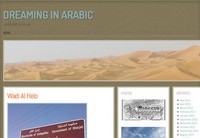- Home » Expat Contests » Expat Blog Awards 2013 - Top 10 Archaeological Sites in the UAE
Top 10 Archaeological Sites in the UAE
By: Jolandi Steven
The United Arab Emirates is known for its glitzy, modern buildings and a lifestyle and culture that often make claims of ‘the best’, ‘the biggest’, or ‘the tallest’. Even though it is a clever marketing ploy for luring tourists and their wallets to the region, it gives no hint of its archaeological treasures. The many forts and watchtowers that dot the country are lovingly restored, but what interests me, lies beyond recent history. I have chosen archaeological sites that can be visited, and although each site holds specific historical significance, I have also chosen them for their natural beauty, as through visiting these sites one gets to know a side of the UAE far removed from the city lights.
1. Perched on a hilltop just north of Ras-al-Khaimah City, Sheba’s Palace, or Zenobia’s Palace as it is also known, stands sentinel over a vast plain that reaches to the Arabian Gulf. Dating from the 16th century it is the only construction of its type and period in the UAE, and most probably served as the summer residence of the ruler of Julfar, despite the argument that the Portuguese may have built it. Not much remains, but the beauty and quiet that can be found here in the dawn hours are rivalled only by the breath-taking views of the location.
GPS co-ordinates: N25° 49’ 07.40” / E56° 02’ 01.80”
2. An energy of isolation and remoteness cloak the flat, rock strewn landscape at the foot of Jebel Hafeet, despite the fact that the city can be seen from here. The early inhabitants of this area chose the northern escarpment and eastern slopes of this monolith that rises 1200 metres above sea level to bury their dead. Over 500 tombs have been found here, and although most have been lost to development, the ones on the eastern side are protected. A small group of these beehive tombs have been restored to show what they originally looked like and how they were built. Referred to as Hafeet or Mezyad graves, and probably robbed in antiquity, they were reused during later periods, particularly during the Iron Age, as indicated by the bronze objects, soapstone vessels and beads that have been found here. It is a great place to soak up the peacefulness this barren land has to offer, and there are always camels in the area for a up-close-and-personal experience of these curious creatures.
GPS co-ordinates for the tombs: N24° 2′ 43.2″ / E55° 48′ 02.5″
GPS co-ordinates for crossing the berm that lies between the road and Jebel Hafeet: N24° 2′ 40.9″ / E55° 50′ 31.8″
3. Just south of Ras-al-Khaimah City lies Al Hamra Village, an expat enclave of modern houses, hotels and a golf course. Huddling in its shadow is Jazirat Al Hamra, the old village that now lies in ruins and is popularly referred to as a ghost village haunted by powerful djinn. It provides a glimpse into what life looked like before oil was discovered and life in the area focused on the sea in the form of pearling and fishing. Even though the village is crumbling away, the houses are still privately owned. Once home to the Zaabi tribe, it has the look of a sandcastle village built from coral stone and bricks, sand and seashells, and although a mere 50 years ago still teemed with life, it now helplessly watches the encroachment of development, whilst slowly succumbing to the onslaught of the natural elements.
GPS co-ordinates: N25° 42’36.8” / E55° 47’ 37.8”
4. Wadi Al Helo in a chunk of the Emirate of Sharjah that lies on the East Coast is a place that holds immense natural beauty. The mountains represent giant rubble piles. The tinted earth is a study in brown with shades and shadows creating depth and variation, often against the backdrop of a blue canvas sky. The dry river bed speaks of rushing water that has passed through with a violent urgency, and the dead date palm trees at the entrance serve as a stark reminder of the brutality of this landscape in the absence of water. It is here, where human habitation stretches back as far as the Bronze Age, that an archaeological site crouches behind a more recent circular watchtower. Managed by the Sharjah Directorate of Antiquities, it unfolds like a giant puzzle with pieces scattered and buried over quite a large area. Neat pathways lead through graves, neat excavations and stones stacked on top of one another to represent the buildings that once stood here. Copper artefacts of more than 4000 years old have been found here, including a copper ingot weighing almost 5 kilograms, which serves as proof that copper from local ore has been produced here. According to the team of archaeologists that has excavated the site, copper was produced here both during the Bronze Age and the later Islamic Period.
GPS co-ordinates: N24° 59’ 25.8” / E56° 13’ 6.8”
5. Sir Bani Yas Island, together with Dalma Island, belongs to a group of eight islands referred to as the Desert Islands just off the Abu Dhabi coast. Sir Bani Yas Island, lying only 9 kilometres off-shore from Jebel Dhanna, is still a fairly new island, as it was still connected to the mainland as recent as five to ten thousand years ago. It is believed that the first humans arrived here about six thousand years ago. An interesting pre-Islamic archaeological site that can be visited here is the remains of a Christian monastery, which in all likelihood belonged to the Nestorian Church, and is believed to date back to the 6th century AD and was most probably in use until about 750 AD. Ongoing excavations are taking place to learn more about it, while there are many more archaeological sites that have been found on the island that range from Late Stone Age to Early Islamic structures. Under Sheikh Zayed’s patronage trees were planted and various animals introduced to the island. The Arabian Wildlife Park takes up about half of the island where animals native to the Arabian Peninsula now roam freely, and successful breeding programmes that include the Arabian Oryx, are conducted here. It is also home to various luxury resorts.
For more information on how to get there visit the Desert Islands Website: http://www.desertislands.com/EN/
6. The barren mountains and rock-strewn valleys around Ras-al-Khaimah are often reluctant to give up the past, and even with GPS co-ordinates to guide the modern day explorer, some of the sites can be difficult to find. A point in case is the pottery kilns Wadi Haqil shelters. These kilns once baked the famous Julfar pottery from as early as the 14th century until as recent as the 1970s. It is a place of extended creativity and desolation, where the ruined houses of the potters that once lived here serve as a reminder of the vulnerability of human existence in a landscape where the harsh climate dictates the rhythms of life. The ancient town of Julfar, the precursor of modern-day Ras-al-Khaimah, disappeared over time, yet the famous Julfar ware that could be found throughout the Gulf region, Yemen, Saudi Arabia and as far afield as the east coast of Africa were continued to be manufactured. Julfar pottery is unglazed, coarse earthenware with a dark orange or grey body and a rough, hackly fracture. It was either plain or decorated with rust-red or purple paint, sometimes on top of a whitewash or thin paint.
GPS co-ordinates: N25° 49’ 14.00” / E56° 02’ 51.00”
7. Human settlement of Dalma Island reaches as far back as the Stone Age, which makes it one of the oldest inhabited places in the UAE. The charred date stones, dating from the late 6th to early 5th millennium BC that have been found here, are some of the earliest forms of evidence of the consumption of dates in Arabia. This volcanic island functioned as an important centre during the apex of the pearl trade, mostly because of its fresh supplies of water in the form of wells, and in the late 19th century was the only island on the Great Pearl Bank that was inhabited year round. The house of former pearl merchant Muhammad Bin Jasim al-Muraykhi, built in 1931, now houses the Dalma museum where local finds are on display. More than 20 archaeological sites are scattered around the island that measures only 9 kilometres from north to south, and spending time here can be a very rewarding experience. Buried treasure in the form of sacks of pearls is rumoured to be buried somewhere on the island.
Dalma Island can be reached within 1.5 hours by car ferry (http://dot.abudhabi.ae/en/info/Ferry_Services), from the Dalma Jetty at Jebel Dhanna, near Ruwais. It can also be reached by air from Abu Dhabi: http://www.adac.ae/english/airports-and-companies/airports/delma-island-and-sir-bani-yas-island-airports.aspx
8. Hili Archaeological Park on the outskirts of Al Ain encloses part of the largest Bronze Age complex in the UAE, and is mostly a tranquil space where past and present meets. The public park that enfolds tombs, where hundreds of bodies were unearthed, is a popular gathering place for families and friends to relax and socialise, especially during the winter months. By examining the remains, scientists came to many interesting insights that provide a rare glimpse into the lives of those who once walked these desert plains. With a general life expectancy of only around 40 years, a high child mortality rate, and general malnutrition that led to serious tooth problems, life here was a struggle for survival. It is a great place to visit during the late afternoon when birds and cats have most of the place to themselves, just before the voices of children on bicycles and go-karts start to fill the air with laughter. By celebrating life here, one is also inevitably celebrating the past.
GPS co-ordinates: N24° 17’ 34.1” / E55° 47’ 32.1”
9. The present-day Shimal neighbourhood on the outskirts of Ras-al-Khaimah has cradled life from the early Bronze Age. Here the Um An Nar tombs from the early Bronze Age (2600-2000BC), the Wadi Suq tombs from the Bronze Age (2000-1600BC), and a late Bronze settlement (1600-1200BC) rub shoulders with modern-day farmers, and the over-spill from city life. Excavated and forgotten, it is now only the goats that regularly trudge between these stones where rusty barbed wire fences put up a feeble attempt to keep visitors out. The treasures that were unearthed from these sites are housed in the RAK museum where they are safely kept behind thick glass.
GPS co-ordinates for the Wadi Suq Tombs: N25° 52’ 32.00” / E56° 03’ 23.00”
GPS co-ordinates for the Um An Nar Tombs: N25° 49’ 54.7” / E56° 01’ 32.9”
10. Bida Bint Saud or Qarn Bint Saud lies about 15km north of Al Ain. Rising 40 metres above the surrounding landscape, this rocky outcrop has been the focus of early civilisations. Hafeet-type graves that date back to 3000BC have been found at its base, while a group of graves dating to the Iron Age and a group dating to the Bronze age have been found on the top of the outcrop. Although no skeletal remains have been found here, many other artefacts have, that gives a clear indication of continual habitation in the area. A couple of hundred metres west of this natural outcrop the remains of a mud brick village and a falaj, concealed by sand, have also been found. Fenced in, there is unfortunately no access to the site, but the red dunes surrounding it, is a great place for a hike or a picnic.
GPS co-ordinates to Bida bint Saud: N24° 22’ 54.3” / E55° 43’ 11.2”
* * *
A quick guide to the three time periods of archaeology is offered below, although dates may vary depending on the region:
Stone Age: It is believed that this time-period began about 2.5 million years ago, while the transition out of it took place around 6000-2500 BC.
Bronze Age: Begins around 3000 BC
Iron Age: Begins around 1000 BC
Grab a badge that links to this contest entry!
 Copy and paste code to display this Contest Entry Badge:
Copy and paste code to display this Contest Entry Badge:Contest Comments » There are 28 comments

MELINDA BROVELLI wrote 11
years ago:
Jolani Steven's blog, Dreaming in Arabic, drew me initially by the name. Once I was in, I was truly dreaming away, reading her thoughtful, eloquent, and often poetic descriptions of places she has visited and stumbled upon. Along with her vivid words are her vibrant and compelling photographs that always give a unique perspective on the world she shows us, her readers. I always look forward to her posts. I know I will be taken away to another world, both dreamy and real at the same time. One word for Ms. Stevens' blog: BRAVISSIMO!

Mike Steven wrote 11
years ago:
Hi Jolandi I do appreciate being dragged off to go and look at rocks, literally or verbally. My favorite is of course the ghost village at Jazirat Al Hamra followed by Wadi Helo. I am grateful that you are able to write about these things that others may share these places. Your GPS coordinates make it very easy to find the places. Thanks Mike

June Molloy Vladička wrote 11
years ago:
Very interesting article, Jolandi, and beautifully written as ever. My only experience with UAE is from the window of the airport on my way to Sydney. You make these sites sounds very enticing. Of course, those that are linked to food history such as Dalma Island are always going to be the first on my list if I ever make it out of the airport!

Yuna wrote 11
years ago:
Hi Jolandi, Simple and informative explanation, with stunning photographs (in your late post). i never have thought about planing a trip to UEA until you posted about this 10 archeological sites. These are so much better and more alluring than those ‘the best’, ‘the biggest’, or ‘the tallest’ modern buildings for me. I'm a geologist after all :D. p.s. Wish you so much luck :)

Safia Moore wrote 11
years ago:
This was such an interesting read, but your blog always is, Jolandi. I know Al Hamra al Jazira village but will have to put the pottery kilns and Sheba's palace on my RAK 'to do' list now.

Lyn Ramsell wrote 11
years ago:
Great article Jolandi - you manage to bring history to life with your description and your passion for it all really shines through.

Deb Adcock wrote 11
years ago:
Jolandi opens up a world of possibilities with her vivid and exciting descriptions of places I have passed by and not visited. Jolandi's top ten will be the basis for my explorations. Thank you for such an informative and well written list

Yvonne Cole wrote 11
years ago:
I have been following Jolandi's Blog "Dreaming in Arabic" for a long time, her blog is superlative! and its like reading 1001 Arabian Nights! I have been waiting with some impatience for her article to appear here! and as usual totally and utterly breathtakingly original and brilliantly written. Buenisimo!!

Tim Tendick wrote 11
years ago:
I've been reading "Dreaming in Arabic" blog regularly for months now, and always enjoy it. But this post is a bit of a problem for me...in that now I feel a pressing need to go to the UAE. Palaces, ancient places of worship, and animal breeding parks? Yes, definitely a problematic post.

Hayley Grace wrote 11
years ago:
Put together by someone who clearly has a passion for the subject!, this is a really interesting article because I enjoy a good ruin - especially very historic ones such as these - and especially when read in conjunction with the photos on Jolandi's Dreaming in Arabic blog.

Gill Wallace wrote 11
years ago:
Love your blogg Jolandi and as we are currently holidaying in RAK it has been very inspirational and we are now planning a visit to Jazirat Al Hamra before heading home :) Keep up the good work and we are looking forward to exploring more of the UAE thanks to you

Peggy Bright wrote 11
years ago:
I lived in four MIddle Eastern countries in the 1970s and 1980s. I cherish Jolandi's knack for refreshing my dreaming in Arabic and for introducing me to the UAE, which I have now added to my must-visit list.

Sheban wrote 11
years ago:
There's so much unexplored history to the UAE. Kudos to Jolandi for putting up such detailed write-ups! With few resources on exploring the old-forgotten lands in the UAE - her list is the perfect place to start. I shall now go stare at the GPS co-ordinates on Google Earth!

Riana wrote 11
years ago:
OK, this is not fair. I´ve been to the UAE from just after Christmas last year to the beginning of this year, thinking that I´ve seen and done almost everything that I wanted to see and do. Another tick on my list, been there, done that, the whole story... A great experience! Just to realise that I need to go back. Jolandi has been my inspiration to go there the first time and she is doing it again with her Top Ten List. Once was not enough. Jolandi, thank you for an inspiring, wonderfull blog that makes me dream about the next time. I´ll be back.

Rosa wrote 11
years ago:
Hi Jolandi - thanks for sharing your moments in the UAE! We're enjoying reading your blog and would like to visit those places.

Antonio wrote 11
years ago:
Great blog, i have to go and visit all ten sites soon, but do not know when.

Louise Van Niekerk wrote 11
years ago:
Bravo to Jolandi - a farmgirl from South Africa. She know what she is doing.

Samantha wrote 11
years ago:
Beautiful pictures, very interesting and helpful article. I've never been in the UAE, but now, after reading this article, i'd like to! Carry on writing good articles like this :)

Beatingthetrack wrote 11
years ago:
I lived in The UAE in the 1970's so it's fantastic for me to be able to read about Jolandi's life in a similar setting in the twenty first century. It's a pleasure to read such insightful pieces, accompanied by amazing photographs. It's also refreshing to read about her exploits off the beaten track. I know from first hand experience, how beautiful the desert can be, and she is generously sharing her adventures with those of us lucky enough to have found her blog.

Tracy Saunders wrote 11
years ago:
How can you not be drawn to a blog called Dreaming in Arabic? Arabic is the perfect language for dreams: soft, seductive, mysterious, drenched in symbols from the unconscious ... maybe even a little bit dangerous. Yolandi Steven's descriptions of places which also fit these adjectives make me want to dust off my backpack and just GO! I especially appreciated the links and the GPS references. At least I can say (for now): Google Earth, here I come.

Veronica Ellis wrote 11
years ago:
As it is my dream to travel the world before I am sixty, I am always looking for interesting places to visit. Before reading this blog, I had not considered the UAE as a destination, but now these sites are definitely on my bucket list. Thank you, Jolandi I will definitely be following you around the world.

Liza-Mari wrote 11
years ago:
Hallo 'tannie' thanx for the great article one day our family will come and visit.. Keep on writing, it is great!!!

Jesus Alberto Arcay Fernandez wrote 11
years ago:
This talented writer is to blame for growing my bucket list The way she describes the sites, the forts,the colours of the marketplaces, the smell, the heat..., makes me feel as I was there. Is there a better way to travel ?... and cheeper ? But One day I will also make my "dream in Arabic" come true and travel to those magic places full of history. Until then, I will wait turning the cold winter European landscapes into hot Arabian deserts.

Catalina wrote 11
years ago:
I like to read about beautiful places and to dream about going there one day. Thank you for helping me dream.

Sarah Hedeen wrote 11
years ago:
On mornings when the beauty around me fails to stir my soul, I turn to 'Dreaming in Arabic' for inspiration. As if the photographs in their clarity depicting the rawness and shivering beauty of the land are not enough, there are the finely textured words that entwine my heart with this place. A blog many cuts above.

Marc Davies wrote 11
years ago:
Great piece - really well written, informative and wonderfully descriptive. The UAE sounds more and more interesting by the paragraph. M.D.

Erin FB wrote 11
years ago:
wow - you're really serious with the GPS coordinates and everything. None of this turn right at the white picket fence stuff for you. Guess one likes to be precise when wandering the desert. Photo with the barbed wire on the "entice you" page is awesome!

Kippy Ayrton-white wrote 11
years ago:
I have been recently introduced to Jolandi's blog "dreaming in arabic". I can't complement her highly enough on both her writing style and the photography. A sumptious feast of images and information, a thought-provoking blog with real depth that inspires, fascinates, and conjures up desert dreams and flights of fantasy. I loved the camel article. I have never considered camels to be beautiful. But seeing Jolandis photos, now I do! I myself also love to go and "look at rocks", so this article really hit the spot. I want to see the rocks that Jolandi has seen! On a last note, I think the opening photo of the blog, that little botanical jewel flourishing in the desert, is a perfect analogy for the quality of jolandi's blog. Thanks Jolandi! Dream on..!!
 Jolandi Steven is a South African expat living in United Arab Emirates. Blog description: Follow Jolandi Steven's adventures in the UAE as she records the surprising, memorable, unusual, as well as the mundane life has to offer in the desert.
Jolandi Steven is a South African expat living in United Arab Emirates. Blog description: Follow Jolandi Steven's adventures in the UAE as she records the surprising, memorable, unusual, as well as the mundane life has to offer in the desert.





